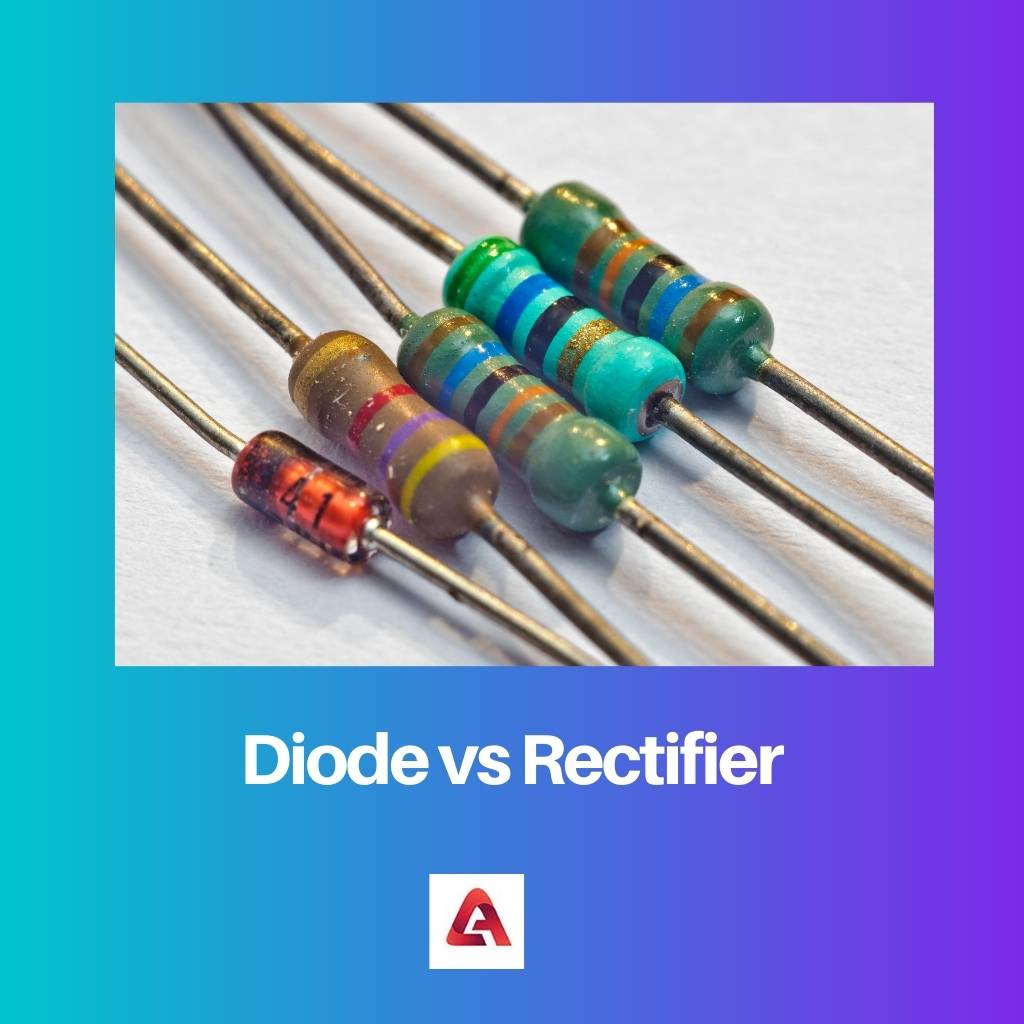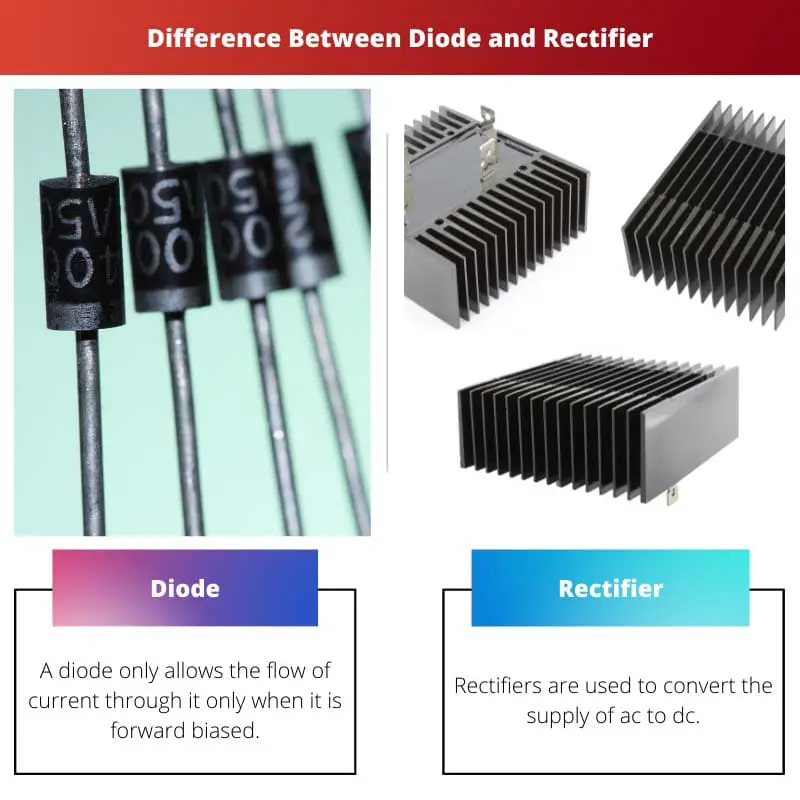Many inventions are created in which the most common and basic stuff is included. Most people even don’t know about it. These are basic parts of the bigger creations which we use on a regular basis.
They are even not even visible, but they perform and make great big happening possible. Two devices such as that are a diode and a rectifier. They are basic devices used to make big devices for their functioning and proper working.
A rectifier is used to manage the type of current supply a device needs, whereas a diode is used to manage the type of current flow required.
Key Takeaways
- Diode is a two-terminal electronic component that conducts current in one direction while blocking it in the other direction.
- A rectifier is an electronic circuit that converts AC voltage to DC voltage using one or more diodes.
- Diodes are commonly used as voltage regulators, oscillators, and switches, whereas rectifiers are used in power supplies and battery chargers.
Diode vs Rectifier
A diode is a two-terminal semiconductor device that allows the current to flow in one direction only. It is used as a switch. The rectifier is an electrical device used to convert an oscillating two-directional AC voltage to a single-directional DC voltage.

The diode is a semiconductor. It is a device that is used as a one-way switch for current flow. It allows current to flow from one direction very easily, whereas it strictly stops current from flowing through the other direction. The diode also has polarities which as anode and cathode.
A rectifier is a device used for the conversion of the supply of ac (Alternating current) to dc (direct current). The procedure of this conversion is known as rectifying.
In the 20th century, most rectifiers were made of metals like iron, copper, and silver, whereas nowadays, they are made of semiconductors.
Comparison Table
| Parameters of Comparison | Diode | Rectifier |
|---|---|---|
| Working | A diode only allows the flow of current through it only when it is forward biased. | Rectifiers are used to convert the supply of ac to dc. |
| Current capacity | The current carrying capacity of the diode is low. | The position of current capacity in rectifiers is high. |
| Type | There are many types of diodes such as a photodiode, Zener diode, and more. | There are two types of rectifiers: single-phase and three-phase rectifiers. |
| Application | A diode is used in switches and clippers. | Rectifiers are used in computer systems. |
| Material | A diode is made of germanium and silicon. | Rectifiers are made of metals like copper, silver, and iron. |
What is Diode?
The diode is a semiconductor. It is a device that is used as a one-way switch for current flow. It allows current to flow easily from one direction, whereas it strictly stops current from flowing through the other direction.
The diode also has polarities which as anode and cathode. The anode should have a higher potential than the cathode to be in a forward bias circuit, i.e., to allow current to flow through the circuit.
The situation where the cathode is on higher potential than the anode will lead to its configuration as in reverse bias, in which it will not allow current to flow through.
A diode can also be used as a rectifier in some situations, and they are rated according to the type, current capacity, and voltage. They are made up of germanium, Gallium Arsenide, and silicon.
A diode only allows current flow only when it is forward biassed, and, in this case, if it is connected in a reverse bias situation, it leads to performing as an insulator.
It can also be used to extract modulation in the radio signals from the radio receivers. There are many types of diodes, such as:
- Light Emitting Diode.
- Laser diode.
- Avalanche diode.
- Zener diode.
- Schottky diode.
- Photodiode.
- PN junction diode.

What is Rectifier?
A rectifier is a device used for the conversion of the supply of ac (Alternating current) to dc (direct current). The current can only be allowed to flow through in one direction.
The procedure of this conversion is known as rectifying. In the 20th century, most rectifiers were made of metals like iron, copper, and silver, whereas nowadays, they are made of semiconductors. There are two types of rectifiers based on the waveform:
1. Half-wave rectifier: half-wave rectifier can only allow ac current to flow through it. Either it allows the positive form of the wave or the negative wave. It blocks the other waveform
2. Full-wave rectifier: full-wave rectifier allows ac current to flow through it as well as dc current too. The full-wave rectifier inputs the whole wave and converts it to one form at the output. That form can be either a positive waveform or a negative waveform.
The opposite working of the rectifier can be done by using the inverters. They are used in various places, but these rectifiers’ most common usage area is DC power supplies and high-voltage direct-current power transmission systems.
They are classified into two types of rectifiers. Firstly, single-phase rectifiers are used in domestic supplies most of the time, whereas the other type, which is a three-phased rectifier, is most commonly used in industrial commodities.

Main Differences Between Diode and Rectifier
- A diode only allows the flow of current through it only when it is forward biased, whereas Rectifiers are used to convert the supply of ac to dc.
- The current carrying capacity of a diode is low, whereas the position of current capacity in rectifiers is high.
- There are many types of diodes, such as photodiodes, Zener diodes, and more, whereas There are two types of rectifiers: single-phase and three-phase rectifiers.
- A diode is used in switches and clippers, whereas Rectifiers are used in computer systems
- A diode is made of germanium and silicon, whereas Rectifiers are made of metals like copper, silver, and iron.

- https://www.sciencedirect.com/science/article/pii/S016521251300036X
- https://iopscience.iop.org/article/10.1088/0953-8984/16/10/L04/meta
- https://pubs.acs.org/doi/abs/10.1021/jp9608990
- https://aip.scitation.org/doi/abs/10.1063/1.1142305
- http://proceedings.mlr.press/v15/glorot11a
- https://www.annualreviews.org/doi/abs/10.1146/annurev.physiol.59.1.171

The comparison table and detailed explanations of diodes and rectifiers have enriched my understanding of these fundamental components. Thank you for sharing this valuable information.
The discussion of half-wave and full-wave rectifiers sheds light on their distinct characteristics and applications in converting AC to DC current. I appreciate the depth of information provided in this article.
This article provides a clear and concise explanation of the differences between diodes and rectifiers. It’s fascinating to learn how these basic electronic components are crucial for the operation of complex devices.
The historical context of rectifiers and the technological advancements in their material composition offer an insightful perspective on the evolution of electronic components.
I was not aware of the importance and usefulness of diodes and rectifiers in the functioning of our everyday electronic devices. This article has been eye-opening for me.
The historical context of rectifiers and the transition to semiconductor-based construction adds historical significance to the discussion of rectifier devices. This article provides a comprehensive overview of rectifier technology.
The practical applications and various types of diodes highlighted in this article illustrate the versatility and importance of these semiconductor devices in modern electronics.
The distinction between forward bias and reverse bias in diodes, along with their diverse applications, showcases the significance of these components in electronic engineering. The article offers valuable insights into their functionality.
The detailed description of diode functionality and rectifier operation provides a comprehensive overview of their roles in electronic circuits. It’s impressive how these devices enable the smooth functioning of electronic systems.
The categorization of diodes, including light emitting diodes (LEDs) and laser diodes, showcases the broad range of functionalities served by these components in electronic systems. The article effectively communicates the importance of diodes in various contexts.